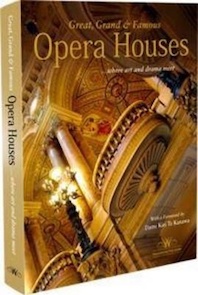
Book review: ‘Great, grand & famous opera houses … where art and drama meet’, 2013
By Mike Day
Presented by Fritz Gubler with a Forward by Dame Kiri Te Kanawa; An imprint of Arbon Publishing Pty Ltd, Crows Nest, Australia 2012
This is a very impressive enterprise. Written and published in Sydney by a team of 11 very experienced writers, musicians, theatre practitioners and designers, with chief consultant Mofatt Oxenbould AM, it provides a substantial amount of information about the early history and recent personalities and productions of 70 of the world’s most important opera houses. It also includes many pages on the development of the art form in various countries plus it details all the elements, skills and understanding needed to bring an artistic vision to an audience in a dedicated purpose built space – impresarios, writers, composers, singers, conductors, musicians, directors, voice coaches, set and costume designers, make-up artists, architects, stage mechanics, acousticians, etc, etc. Newcomers to opera will find this very useful to further their understanding of the enormous resources and dedication needed.
Experienced and well-travelled opera goers will be gratified and fascinated to read detailed information and anecdotes about familiar stars and performances, plus facts about the buildings, their architects, dates of construction and reconstruction, and much more, for their favourite theatres. Some may be disappointed that a particular theatre wasn’t included but the book is already bursting with treasures. There are several I was unfamiliar with that are now on my “bucket list” and I was very pleased that the Grande Theatre in Bordeaux is documented – its restrained limestone neoclassic style exterior and foyer are superb. Perhaps Latvia’s Riga Opera House should have been included and I would have liked a mention of the magnificent Valetta Royal Opera House in Malta, destroyed in WW2, but the editors obviously had to draw a line somewhere to keep the size manageable – it’s already too bulky to read in bed. As an architect I would have found useful the inclusion of basic plans and sections of the most important houses, particularly Palais Garnier and the Bayreuth Festspielhouse, to give a sense of the scale and spatial complexity of these extraordinary constructions.
The book is handsomely bound and beautifully printed in full colour with many wonderful photos and artworks but as a designer (and older reader) I found the page layouts rather busy and cramped, with too many decorative flourishes, and would have preferred much more white space to give the eye a rest. However these are small criticisms for a book that I found so delightful.
I thoroughly recommend it as both an impressive coffee table book and also a useful reference, as it is thoroughly indexed and referenced, with a comprehensive glossary and bibliography.
I think I can speak for all lovers of opera (and lovers of great architecture) when I say that it is the passion on display that attracts us to go to the opera house and the best thing about this book is the obvious passion and love as well as deep practical knowledge that all 12 contributors have shown in putting the work together. If I had never been to an opera before I would certainly want to go after reading this book.
Mike Day is a committee member of the Wagner Society in NSW, a qualified Architect and Lighting Designer and Lecturer in Stagecraft and Lighting in the School of Design, University of Technology Sydney. He has designed operas for the Aldeburgh Festival and Kent Opera and was one of the instigators of the Vivid Sydney Smart Light Festival in 2009.
This profusely illustrated coffee table book has entries by members Leona Geeves, Paulo Montoya, Victoria Watson, amongst others – ED. SPECIAL OFFER for Wagner Society members. Order and receive $20 off the RRP ($79.99) + FREE SHIPPING Simply visit www.arbonpublishing.com or call 02 9437 0438 and use the code: WAGNERSOCIETY
